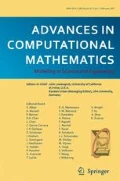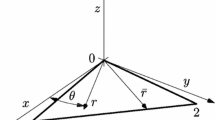Abstract
The standard approach to calculating electrostatic forces and capacitances involves solving a surface integral equation of the first kind. However, discretizations of this problem lead to ill-conditioned linear systems and second-kind integral equations usually solve for the dipole density, which can not be directly related to electrostatic forces. This paper describes a second-kind equation for the monopole or charge density and investigates different discretization schemes for this integral formulation. Numerical experiments, using multipole accelerated matrix–vector multiplications, demonstrate the efficiency and accuracy of the new approach.
Similar content being viewed by others
References
K.E. Atkinson, The numerical solution of Laplace's equation in three dimensions, II, in: Numerical Treatment of Integral Equations, eds. J. Albrecht and L. Collatz (Birkhäuser, Basel, 1980).
K.E. Atkinson, User's guide to a boundary elemant package for solving integral equations on piecewise smooth surfaces, Reports on Computational Mathematics 43, The University of Iowa (1993). Available via anonymous ftp at ftp.math.uiowa.edu.
K.E. Atkinson, The Numerical Solution of Integral Equations of the Second Kind(Cambridge University Press, 1997).
K.E. Atkinson and D. Chien, Piecewise polynomial collocation for boundary integral equations, SIAM J. Sci. Statist. Comput. 16 (1995) 651-681.
A. Greenbaum, L. Greengard and G.B. Mc Fadden, Laplace's equation and the Dirichlet-Neumann map in multiply connected domains, J. Comput. Phys. 105 (1993) 267-278.
L. Greengard, The Rapid Evaluation of Potential Fields in Particle Systems(MIT Press, Cambridge, MA, 1988).
L. Greengard and V. Rokhlin, A fast algorithm for particle simulations, J. Comput. Phys. 73 (1987) 325-348.
W. Hackbusch and Z. Novak, On the fast matrix multiplication in the boundary element method by panel clustering, Numer. Math. 54 (1989) 463-491.
E.W. Hobson, The Theory of Spherical and Ellipsoidal Harmonics(Chelsea, New York, 1965).
O.D. Kellogg, Foundations of Potential Theory(Dover, New York, 1959).
S.G. Mikhlin, Integral Equations(Pergamon Press, New York, 1957).
K. Nabors, F.T. Korsmeyer, F.T. Leighton and J. White, Preconditioned, adaptive, multipole-accelerated iterative methods for three-dimensional first-kind integral equations of potential theory, SIAM J. Sci. Statist. Comput. 15(3) (1994) 713-735.
K. Nabors and J. White, Fastcap: A multipole accelerated 3-D capacitance extraction program, IEEE Trans. Computer-Aided Design Integrated Circuits and Systems 11(10) (1991) 1447-1459.
J.N. Newman, Distribution of sources and normal dipoles over a quadrilateral panel, J. Engrg. Math. 20 (1986) 113-126.
V. Rokhlin, Rapid solution of integral equations of classical potential theory, J. Comput. Phys. 60(2) (1985) 187-207.
Y. Saad and M.H. Schultz, GMRES: A generalized minimal residual algorithm for solving nonsymmetric linear systems, SIAM J. Sci. Statist. Comput. 7(3) (1986) 105-126.
I. Sloan, Error analysis of boundary integral methods, Acta Numerica (1991) 287-339.
Author information
Authors and Affiliations
Rights and permissions
About this article
Cite this article
Tausch, J., White, J. Second-kind integral formulations of the capacitance problem. Advances in Computational Mathematics 9, 217–232 (1998). https://doi.org/10.1023/A:1018973019922
Issue Date:
DOI: https://doi.org/10.1023/A:1018973019922




